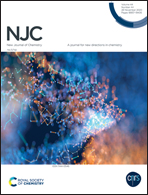Efficient Z-scheme charge separation in WO3/PbWO4 for the removal of organic pollutants†
Abstract
The contact quality of a composite is an important factor for the transfer and separation of photogenerated carriers. For this, we demonstrated a cation exchange method for the in situ construction of WO3/PbWO4 linked by WO6 octahedral crystal structure units, where WO3 was placed on the surface of PbWO4. We found that the apparent rate constant of the as-prepared WO3/PbWO4 was significantly increased (17 times higher than any single one). Our investigation indicated a remarkably enhanced photodegradation rate, originating from high contact quality. The photogenerated carriers of WO3/PbWO4 were greatly separated via the grain boundary, making WO3/PbWO4 exhibit 22 times higher photocurrent density than pristine PbWO4. Moreover, the photoelectrons and holes were separated through the high contact quality grain boundary built-in electric field, which is in accordance with the transmission path of the Z-scheme. Compared with the interface, a grain boundary is more conducive to the photocatalytic process. This study provides a feasible strategy to build a highly efficient Z-scheme photocatalyst with high contact quality grain boundary to remove organic pollutants.



 Please wait while we load your content...
Please wait while we load your content...